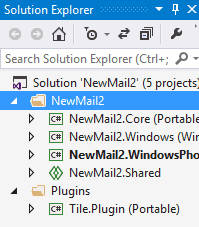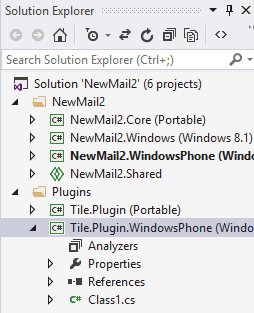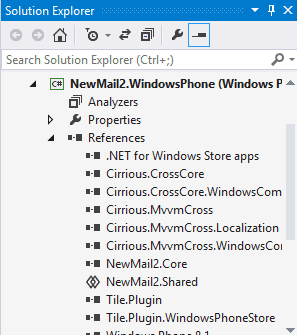This is quite a straightforward process, and well documented in several places - including here and here; and the sample that I used to create mine (and this tutorial) is here. However, I couldn’t find a step-by-step tutorial in a single place. So this is pretty much for my future self.
Disclaimer(s)
This only applies to Windows Store and Windows Phone. Although I believe the same process applies to iOS and Android.
The plug-in that I’m creating here will create a secondary tile on Windows Phone / Windows Store. However, this only covers the phone part, and doesn’t actually cover tile creation.
Create a Project
The project that I’m dealing with is a re-write of this application, using C# and MVVM Cross.
Obviously, your structure may be different, but the important thing is the Plugins folder at this stage; create a new portable project.
Next, add the MVVMCross libraries:
Interface and Plugin Loader
The portable class library above needs two files. Start with creating an interface:
public interface ITile
{
Task<bool> CreateTile(string title);
}
And next, the plug-in loader:
public class PluginLoader : IMvxPluginLoader
{
public static readonly PluginLoader Instance = new PluginLoader();
public void EnsureLoaded()
{
var manager = Mvx.Resolve<IMvxPluginManager>();
manager.EnsurePlatformAdaptionLoaded<PluginLoader>();
}
}
}
Obviously, the next stage depends on your specific implementation. Mine depends entirely on the platform, so that’s all I need to do in the portable library.
Windows Phone
Create a new library project:
As before, you need to add the MVVM Cross Libraries, and a reference to the portable class above:
The next stage is to implement your plug-in logic for the destination platform; in my case, this is logic to add a tile to Windows Phone:
public class TilePlugin : ITile
{
public async Task<bool> CreateTile(string title)
{
// Create Tile code
}
}
Finally, just implement IMvxPlugin like this:
public class Plugin : IMvxPlugin
{
public void Load()
{
Mvx.RegisterSingleton<ITile>(new TilePlugin());
}
}
Using the plug-in - the View Model
So, to all intents and purposes, the plug-in is now written (admittedly it only exists for Windows Phone, but that’s beside the point).
Next, it needs to be used; the first thing is to reference it.
Here’s my logic to actually use the plug-in inside the view model:
class SetupNewMailViewModel : BaseViewModel
{
. . .
private void AddTile()
{
var tile = Mvx.Resolve<ITile>();
tile.CreateTile(MailHeading);
}
}
Using the plugin - Platform Specific
In the relevant project, a reference is needed:
The only thing left to do for the platform is to add the bootstrap code:
public class TilePluginBootstrap : MvxPluginBootstrapAction<Tile.Plugin.PluginLoader> { }
`MvxPluginBootstrapAction` signifies that the call to `MvxSetup` will call the BootstrapRunner for this plugin. Or, to put it another way, this magically makes MVVMCross aware of your new plugin for each platform.
Notes on Deployment
Above, I’ve basically manually added the reference to the correct project. This works fine when I’m working locally, but for an actual distributed plug-in, it’s NuGet that handles this.






